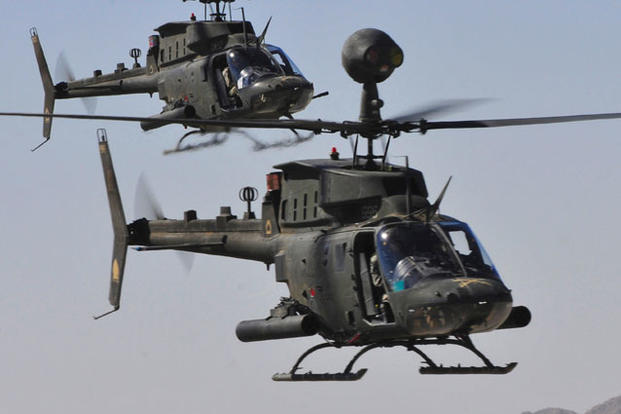The venerable Vietnam-era OH-58D Kiowa scout helicopters have done the job as the valued eyes and ears of the Army's 82nd Airborne Division, but today's more complex battlefields demand the switchover to AH-64 Apaches, Col. Erik Gilbert said Monday.
In a telephone conference from Fort Bragg, North Carolina, Gilbert, commander of the 82nd Airborne's Combat Aviation Brigade, said the Army's "last pure Kiowa Squadron," now deployed to South Korea, is preparing for the switch.
When the 1st Squadron, 17th Cavalry Regiment, 82nd Combat Aviation Brigade, returns to Fort Bragg early next year, the Kiowas will likely be available for foreign sales; some will be put in storage; and others may go to the National Guard, Gilbert said.
"This rotation will be the final Kiowa Warrior Squadron mission in the Army," Gilbert said of the South Korea deployment. He praised the Kiowa's versatility but said the Apache has more speed, durability and firepower, and "is just a far more capable platform."
However, Gilbert acknowledged that the Apaches still can't match the speed at which the smaller and lighter Kiowas can be deployed to a remote airfield and be in the air to provide cover and reconnaissance for ground troops.
Kiowas can go aboard C-130 Hercules aircraft and be in the air within a half hour of landing, Gilbert said, while the bigger and heavier Apaches aboard a C-17 Globemaster take three hours.
The difference, Gilbert said, is that the Kiowas can simply be pushed off the C-130 while the Apaches have to be winched out of the C-17 and "their blades fold up a little differently."
"No other unit in the Army is capable of such rapid night-time employment of AH-64 Apaches," Gilbert said, but "frankly, I think we can get faster."
The great advantage of the Apaches will be their ability to marry up with expeditionary Unmanned Aircraft Systems (UAS) to provide commanders with more battlefield options.
"The UAS is a game-changer for us," Gilbert said. The 82nd Airborne currently has the RQ-7 Shadow UAV, or unmanned aerial vehicle, which can be controlled by an Apache crewman to survey enemy positions and relay information to ground forces.
For commanders, "it gives them another data source," Gilbert said.
In the coming months, the Combat Aviation Brigade also will be acquiring the MQ-1C Gray Eagle UAS, similar to the Predator UAV, which has greater range, Gilbert said.
Against more advanced enemies, the Apaches tend to loiter low to avoid enemy radar, making it "harder for them to pick out targets," Gilbert said, but the UAVs can provide that intelligence at less risk.
The transition from the Kiowa to the Apache was part of the Army's Aviation Restructuring Initiative, a five-year plan aimed at retiring "legacy systems" to make way for newer technologies.
The Kiowa first flew in 1966 and was used extensively from Vietnam to Iraq and Afghanistan. The Kiowas first came to Fort Bragg in 1990.
-- Richard Sisk can be reached at Richard.Sisk@Military.com.
Related Video:































